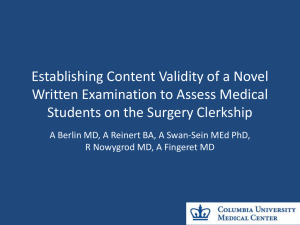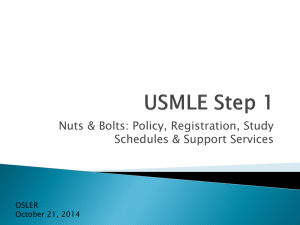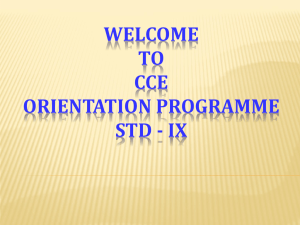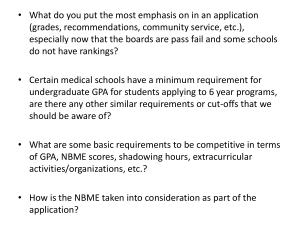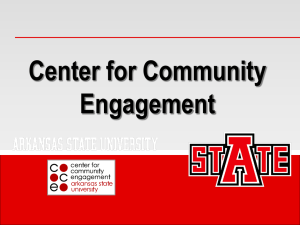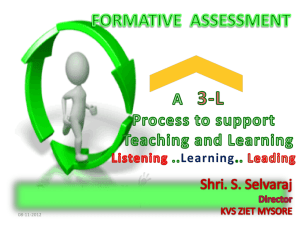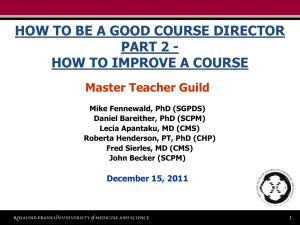2013-04-16-Chuang
advertisement
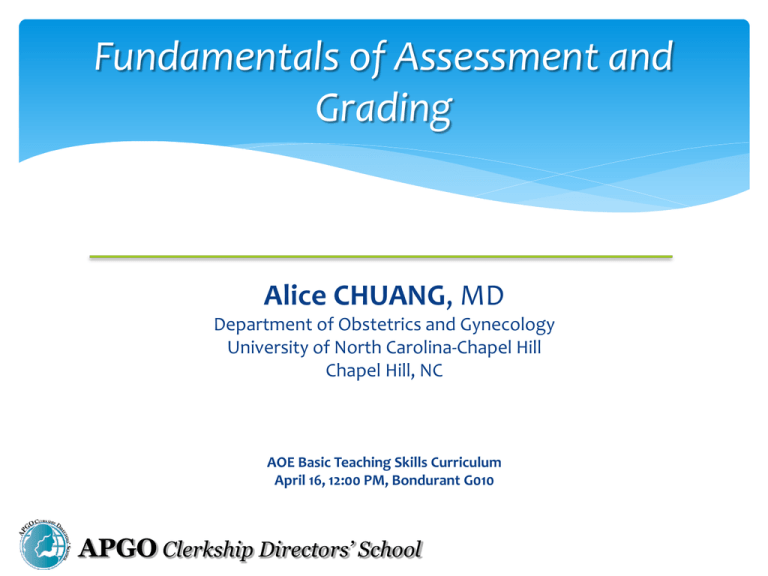
Fundamentals of Assessment and Grading Alice CHUANG, MD Department of Obstetrics and Gynecology University of North Carolina-Chapel Hill Chapel Hill, NC AOE Basic Teaching Skills Curriculum April 16, 12:00 PM, Bondurant G010 APGO Clerkship Directors’ School Neither I nor my spouse has any financial interests to disclose related to this talk. Objectives Understand reliability and validity Contrast formative and summative evaluation Compare and contrast norm-referenced and criterion referenced assessments Improve delivery of feedback Understand the NBME exam Be familiar with different testing formats, their uses and their limitations Terminology Validity: Are we measuring what we think we’re measuring Content: Does the instrument measure the depth and breadth of the content of the course? Does it inadvertently measure something else? Construct: Does the evaluation criteria or grading construct allow for true measurement of the knowledge, skills or attitudes taught in the course? Is any part of the grading construct irrelevant? Criterion: Does the outcome correlate with true competencies? Relate to an important current or future events? Is the assessment relevant to future performance? http://pareonline.net/getvn.asp?v=7&n=10 Examples Validity Content: A summative ob/gyn test which covered only obstetrics Construct: You allow students to use their textbook for a knowledge-based multiple choice test of foundational information on prenatal care. Criterion: New Coke v. Old Coke Terminology Reliability: Are our measurements consistent? The score should be the same no matter when it was taken, who scored it, or when it was scored. Interrater reliability: Is a student’s score consistent between evaluators? Intrarater reliability: Is a student’s score consistent with the same rater even if rated under different circumstances? Scoring rubric: standardized method of grading to increase interrater and intrarater reliability http://pareonline.net/getvn.asp?v=7&n=10 Examples: In general, if you repeat the same assessment, will you get the same answer? Interrater: 3 individuals are asked to go to the beach and estimate how many seagulls they see from 6-7AM and come up with 200, 800 and 1200. Intrarater: A particular food critic always gives low scores for food quality if the server is female. Examples: Show Choir Audition Rubric Poor Candidate 0 points Fair Candidate 1 points Good Candidate 2 points Superior Candidate 3 points Singing Skills Sings with as much expression as a wet noodle, cannot identify which tune candidate is singing, also cannot identify what the lyrics of song are secondary to poor pronunciation Minimally expressive, pitch off significantly on occasion, diction unclear at times Very expressive, sings on pitch most of the time with minor errors, diction clear most of the time Artistically expressive, sings on pitch, diction clear Dancing Skills Has 2 left feet, unable to learn new steps and continues to dance like MC Hammer despite different choreography demonstrated Missteps despite multiple attempts, no artistic expression in dance moves, unable to learn new choreography after 3 demonstrations Occasionally missteps, but overall dance steps are accurate, adapts choreography fairly rapidly, Quick and nimble, dances artistically, able to learn new choreography quickly. Freely admits not knowing what GLEE is Endorses enjoyment of GLEE, but unable to identify favorite character Has watched 70% of GLEE episodes Has seen every episode of GLEE, all GLEE albums confirmed in iTUNES library, has been to GLEE LIVE each summer Enthusiasm for show CHOIR Formative v. summative assessments Formative: on-going assessment, designed to help improve educational program as well as learner progress Summative: designed to evaluate student overall performance at end of educational phase and evaluate effectiveness of teaching http://fcit.usf.edu/assessment/basic/basica.html Examples Formative: short multiple choice exam written in house that is pass/fail; answers are reviewed with class at end of testing session Summative: NBME exam Formative v. summative assessments ED30: The directors of all courses and clerkship must design and implement a system of formative and summative evaluation of student achievement in each course and clerkship. Those responsible for the evaluation of student performance should understand the uses and limitation of various test formats, the purposes and benefits of criterion-referenced vs. norm-referenced grading, reliability and validity issues, formative vs. summative assessment, etc…. Formative v. summative assessments ED31: Each student should be evaluated early enough during a unit of study to allow time for remediation ED32: Narrative descriptions of student performance and of non-cognitive achievement should be included as part of evaluations in all required courses and clerkships where teacher-student interaction permits this form of assessment. Formative v. summative assessments Uses for assessments Formative Summative Purpose Feedback for learning Certification/Grading Breadth of scope Narrow focus on specific objectives Broad focus on general goals Scoring Explicit feedback Overall performance Learner affective response Little anxiety Moderate to high anxiety Target audience Learner Society Characteristics of feedback Effective Feedback: • given with the goal of improvement timely honest respectful clear issue-specific objective supportive motivating action-oriented solution-oriented Destructive Feedback: • unhelpful accusatory personal judgmental subjective It also undermines the self-esteem of the receiver leaves the issue unresolved the receiver is unsure how to proceed. http://www.expressyourselftosuccess.com/the-importance-of-providing-constructive-feedback/ Feedback…from APGO/CREOG 2011 When you… You give the impression… I would stop… I would recommend…instead Norm-referenced v. criterion- referenced assessments Norm-referenced Purpose is to classify students in order of achievement from low to high Allow comparisons of students May not give accurate information regarding student abilities Half of the students should score above midpoint score and the other half should score below midpoint score Rickets C. A plea for the proper use of criterion-referenced tests in medical assessment. Med Educ, Vol 43, Issue 12. Norm-referenced v. criterion- referenced assessments Criterion-referenced Purpose is to evaluate students knowledge and skills compared to a pre-determined goal performance level Gives information about a student’s achievement of certain objectives Should be possible for everyone to earn a passing score Rickets C. A plea for the proper use of criterion-referenced tests in medical assessment. Med Educ, Vol 43, Issue 12. Example Norm-referenced: Soccer tryouts where 11 players are chosen out of 40 Criterion-referenced: Test for driver’s license Norm-referenced v. criterion- referenced assessments Be sure your assessment is appropriately normreferenced or criterion referenced. Be sure that your assessment is designed with this in mind. Most assessments in medical education are criterion-referenced. Norm-referenced tests should emphasize variability; criterion-referenced tests should emphasize accuracy of tested material. NBME Exams Developed by committees and content experts Same protocol used to build Step 1 and Step 2 In general Subject exams provided to all 130 LCME accredited medical school is US 8 Canadian medical schools 8 osteopathic medical school 22 international medical schools NBME Scaled to have a mean of 70 and SD of 8 based on 9000 first-time test takers from 80+ schools who took exam as end-of-clerkship exam in 1993-94 Scores do not reflect percentage of questions answered correctly. NBME: What do those scores mean? Score 2011-2012 Total year Q1 Q2 Q3 Q4 93 or above 98 99 98 97 97 92 97 98 98 97 96 86 90 93 91 89 88 80 75 80 77 73 71 78 67 71 69 63 62 74 49 54 51 45 44 70 29 33 32 26 25 62 6 7 6 5 4 60 3 4 4 3 2 A score of 60 in the fourth quarter means that 2% of the examinees in the fourth quarter scored 60 or below! NBME: Academic purpose for exam % Advanced placement 5 Course/clerkship 95 Year-end 12 Make-up 21 Minimal competence 44 Identify at risk students 23 Practice for USMLE 47 Promotion requirement 37 Review course 1 Student self-assessment 26 Other 4 Total responses: 78 NBME: Weight given the subject exam Weight given the subject exam 1-10% 11-20% 21-30% 31-40% 41-50% >50% Total number responding % 4 16 33 39 13 0 70 NBME 2008 Clerkship Survey Results Assessment/Evaluation Method Ob/gyn (%) Computer Case Simulations 0.5 Subject Exam 30 School’s MCQ Exam 9 Observation and evaluation by residents 28 Observation and evaluation by faculty 26 Oral exam 14 OSCE 12 Peer evaluation 1 Standardized patient exam 3 Other 18 Total number responding 81 NBME 2004 and 2009 survey of performance guidelines across clerkship Recommend setting an absolute versus a relative standard for performance Angoff Procedures: item-based, judges provide guess of minimally proficient examinees that answer each question correctly Hofstee Method: judges determine minimum and maximum scores for passing and percentage of failures…then plotted against a graph made up of exam score and failure rate NBME Testing Formats Multiple choice exam (MCQ) Objective structured clinical examination (OSCE) Oral examination Direct observation Simulation Standardized patient Patient/procedure log Casey et al, To the point: reviews in medical education – the Objective Structured Clinical Medical record reviews Examination. AJOG, Jan 2009. Written essay questions Testing format: MCQ Use distractors which could plausibly represent correct answer Use a question format, not complete-the-statement format Emphasize higher-level thinking, not strict memorization Keep option length consistent within a question Balance the placement of the correct answer Use correct grammar Avoid clues to the correct answer Highly reliable and valid for assessing knowledge http://testing.byu.edu/info/handbooks/14%20Rules%20for%20Writing%20Multiple-Choice%20Questions.pdf Testing format: OSCE Examinees rotate through circuit of stations (5-10 minutes each) One-on-one examination (with examiner or trained or simuated patient) List of criteria for successful completion of each station Each station test a specific skill or competency Good for examining higher-order skills, clinical and technical skills Requires large amount of resources Testing format: Oral Exam Portfolio based: similar to case-based portion of Oral Boards Poor inter-rater and intra-rater reliability Scores higher when scored live verses on video Teaching students how to do better on oral exam does not improve scores Practicing oral exams does improve scores Mock public oral exam improves performance Limitations Halo effect (grade reflects not only performance on exam but also previous experience) Subconscious consensus grading: examiners take subconscious cues from each other. Burch & Seggie, 2008; Kearney et al, 2001; Buchard et al, 2007; Jacobsohn et al, 2006 Testing format: Oral Exam Is an oral exam justified? Is there an advantage? Does the material lend itself to open questioning? How will communication skills, delivery of information be graded? Will only content be graded? Is the examiner experienced? Will he/she skew grades in any way? How will you prepare students for the exam? Is there enough time for every student to examine them adequately? How much prompting/assistance is allowed for oral examination? How much time will you allow for “thinking?” How will you ensure consistency in these areas for all examinees? http://testing.byu.edu/info/handbooks/14%20Rules%20for%20Writing%20Multiple-Choice%20Questions.pdf Testing format: Direct observation Formalized criteria Various observers True-to-life clinical setting (versus simulated) Numerical scores Comment anchored Improve reliability with multiple perspectives Consider 360 evaluation (including self, patient and other staff members) Testing format MCQ OSCE Direct obs Content +++ ++ + + Construct +++ ++ + + Criterion + ++ + + Reliability +++ ++ + + Formative Y Y Y Y Y Y Y Y Normreferenced Y N N N Criterionreferenced Y Y Y Y Summative Oral exam General rules of thumb Be sure your assessment Provides reliable data Provides valid data Provides valuable data Is feasible Can be incorporated into the systems in place (hospital, clinic, curriculum, etc) Is consistent with course objectives Utilizes multiple instruments, multiple assessors and multiple points of assessment Aligns with pre-specified criteria Is fair Lynch and Swing. Key Considerations for Selecting Assessment Instruments and Implementing Assessment Systems. ACGME. References Bond, Linda A. (1996). Norm- and criterion-referenced testing. Practical Assessment, Research & Evaluation, 5(2). Accessed at http://pareonline.net/getvn.asp?v=5&n=2 Burch VC, Seggie JL. Use of a structured interview to assess portfolio-based learning. Med Ed 2008: 42: 894-900. Burchard K et al. Is it live or is it Memorex? Student oral examinatinos and the use of video for additional scoring. Am J Surg. 193 (2007), 233-236 Casey et al, To the point: reviews in medical education – the Objective Structured Clinical Examination. AJOG, Jan 2009. Jacobsohn E , Kock PA, Avidan M. Poor inter-rater reliability on mock anesthesia oral examinations. Kearney RA et al. The inter-rater and intra-rater reliability of a new Canadian oral examinatino format in anesthesia is fair to good. Can J Anesth 2002; 49:3, 232-236. Lynch and Swing. Key Considerations for Selecting Assessment Instruments and Implementing Assessment Systems. ACGME. Metheny WP, Espey EL, Bienstock J, et al. To the point: Medical education reviews evaluation in context: Assessing learners, teachers, and training programs. Am J Obstet Gynecol. 2005;192(1):34-37. Moskal, Barbara M. & Jon A. Leydens (2000). Scoring rubric development: validity and reliability. Practical Assessment, Research & Evaluation, 7(10). Retrieved December 29, 2009 from http://PAREonline.net/getvn.asp?v=7&n=10 Rickets C. A plea for the proper use of criterion-referenced tests in medical assessment. Med Educ, Vol 43, Issue 12. References 14 Rules for Writing Multiple Choice Questions. Brigham Young University 2001 Annual Conference. Accessed at http://testing.byu.edu/info/handbooks/14%20Rules%20for%20Writing%20MultipleChoice%20Questions.pdf Formative vs. Summative Assessments. Classroom Assessment. Accessed at: http://fcit.usf.edu/assessment/basic/basica.html NBME 2008 Clinical Clerkship Director Survey Results. Accessed at https://portal.nbme.org/web/medschools/home?p_p_id=62_INSTANCE_dOGM&p_p_action=0&p _p_state=maximized&p_p_mode=view&p_p_col_id=column1&p_p_col_count=1&_62_INSTANCE_dOGM_struts_action=%2Fjournal_articles%2Fview&_62_INS TANCE_dOGM_keywords=&_62_INSTANCE_dOGM_advancedSearch=false&_62_INSTANCE_dO GM_andOperator=true&_62_INSTANCE_dOGM_groupId=1172&_62_INSTANCE_dOGM_searchAr ticleId=&_62_INSTANCE_dOGM_version=1.0&_62_INSTANCE_dOGM_name=&_62_INSTANCE_d OGM_description=&_62_INSTANCE_dOGM_content=&_62_INSTANCE_dOGM_type=&_62_INST ANCE_dOGM_structureId=&_62_INSTANCE_dOGM_templateId=&_62_INSTANCE_dOGM_status =approved&_62_INSTANCE_dOGM_articleId=817480 Objective Structured Clinical Examination. Wikipedia. Accessed at http://en.wikipedia.org/wiki/Objective_structured_clinical_examination Reliability and Validity. Classroom Assessment. Accessed at: http://fcit.usf.edu/assessment/basic/basicc.html Talk about teaching: Significant issues in Oral Examinations. Contributed by Meryl Carlson, Concordia College, Moorhead, MN. Accessed at http://www.cord.edu/faculty/ulnessd/oral/MCarlson/questions.html

